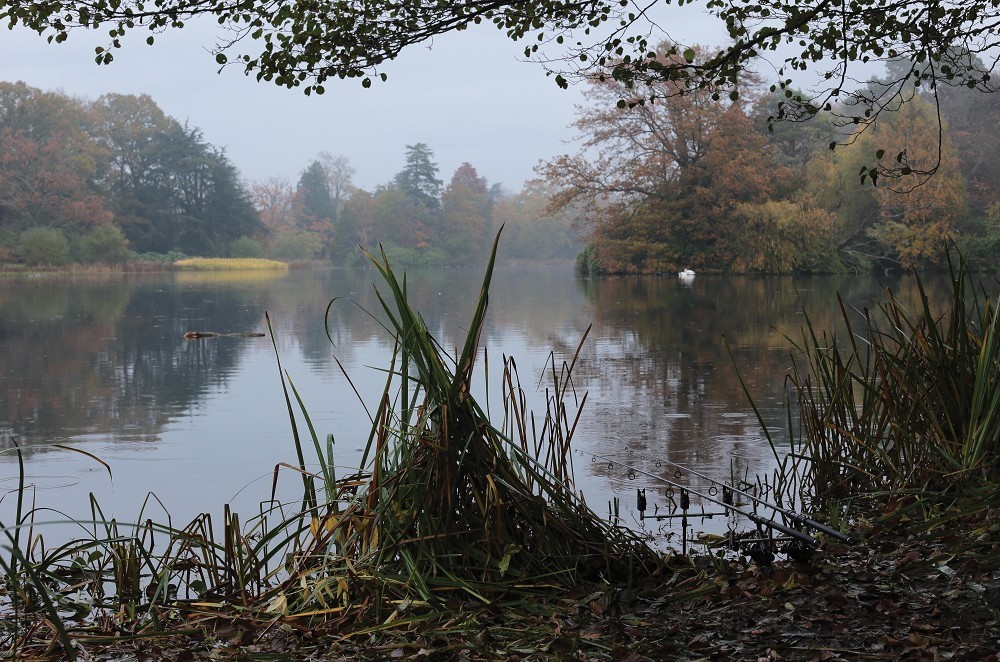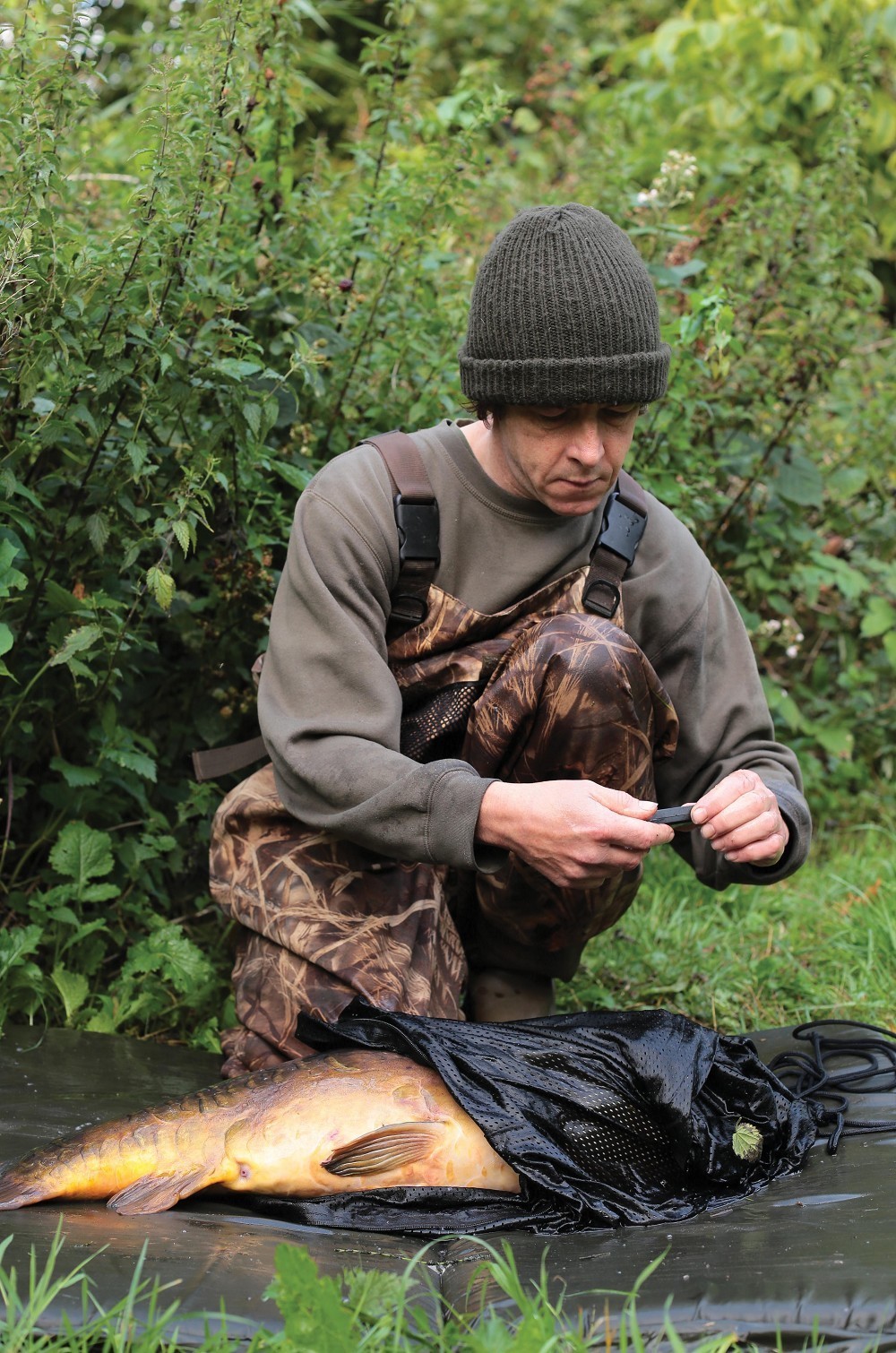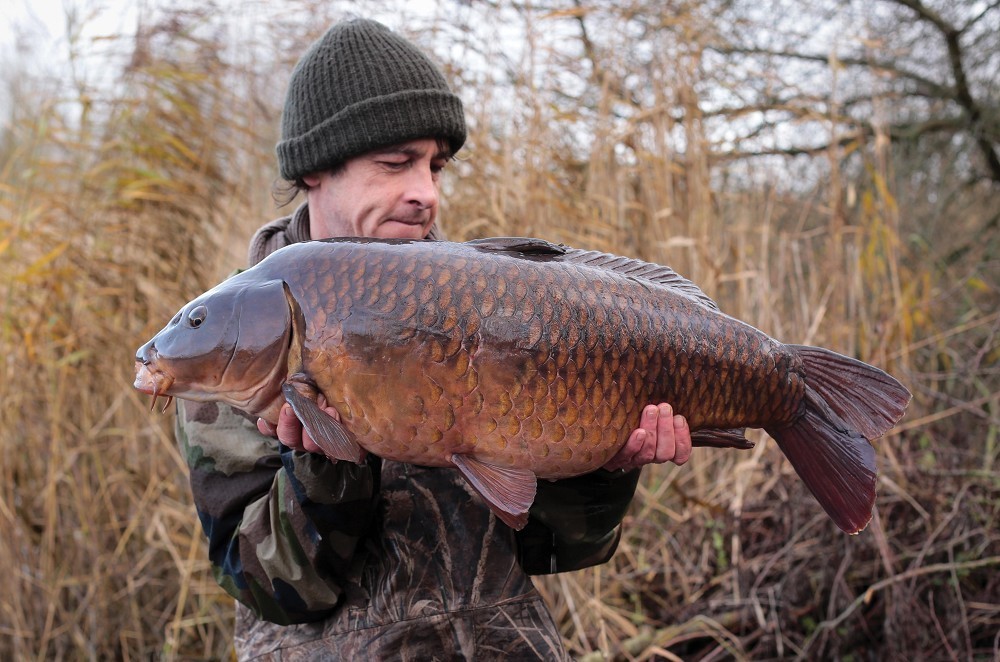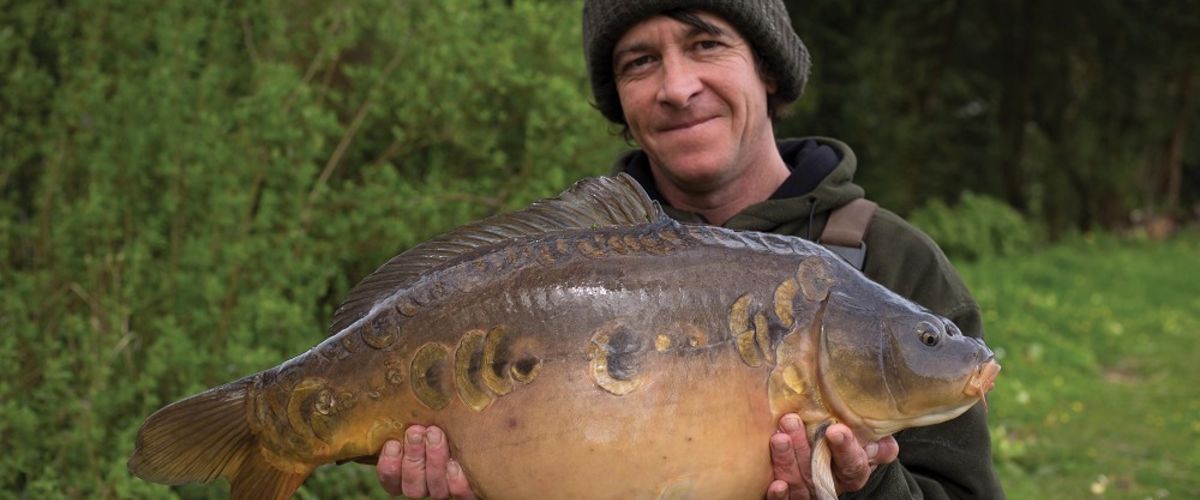
Why hook sharpness is so important
Terry Hearn's thoughts on hook sharpness
Question
Nick Helleur previously asked: “I’ve seen lots written by the likes of Jason Haywood among others about the practice but is sharpening hooks what makes him a successful angler? Of course it’s not. Would he just be another angler if he didn’t sharpen? The answer’s no, he’s a old hand, a very experienced angler that caught plenty long before he ever sharpened a hook and it would be insulting to say he only does any good because he knows how to use a file. Has he turned superhuman in the catching stakes since he started sharpening his hooks? The answer’s still no. He would be consistent regardless. Do you know of an average angler who suddenly became a catching machine because he bought a sharpening stone? Err, again it’s a no. I feel the practice, like so many things in carp fishing, catches more anglers than carp. Believe me, if I was on a lake and being out-caught by someone I felt was a lesser angler solely because he was sharpening his hooks and I wasn’t, I’d be the first to step up but that’s never been the case up to this point and I doubt it ever will be.”
I've given my views on hook sharpness many times in the past, but it’s a good subject and one worth going into a bit more depth with. First off, I want to make it clear that I think hook sharpness is incredibly important and I’m as fussy as it gets, fussy to the point of being paranoid about it. I’ve been that way for a long, long time, and I firmly believe that being as fussy as I have has helped me to catch a lot of carp which I might not have otherwise caught. You know, I still remember commenting to one of the lads on the Yateley Car Park Lake how I reckoned if I was to walk round and check everyone’s hook for sharpness, I doubted that I’d use 90% of them myself. I remember it as well as I do because it was quite a brash thing to say, which I kind of regretted immediately afterwards, but you know what, I meant it. That was twenty odd years ago, and in that time there have been far fewer days that I’ve not tested a hook point than days which I have. Understandably my hook paranoia has become even more extreme.
Hooks don’t just have to stick to my nails with next to no pressure, they have to stick to my nails in a certain way. It doesn’t stop with that last millimetre at the tip either, I like the rest of the point to be as fine as possible, and I like the barb to be suitably sized and positioned. I’m only saying all this to get across to the hook sharpeners that they aren’t any fussier than I am. Believe me, if I thought that the bloke in the next swim was using sharper hooks than me, I’d sit up night after night, day after day and week after week, honing my hook sharpening skills until that was no longer the case.
I know very well the importance a super sharp hook has in carp fishing, which to my mind is more than pretty much all other forms of fishing. We aren’t holding a lure rod and striking within a second of feeling a pluck, and we aren’t sat on the edge of our seats waiting for a quiver tip to rattle or a float to go under. Even on the most prolific of waters, takes are far too few and far between to be striking at every movement, Quick Draw McGraw style, and besides, the ranges we fish at and conditions that we fish in would often make bite indication for that style of fishing very ineffective anyway. So, we have to rely on a bare, super sharp, exposed hook to prick the carp, either when they tighten up to the lead or when they try to blow out the hookbait, otherwise the only time we’d ever catch anything is when a carp shuts its mouth and swims off at pace in the opposite direction, which just isn’t happening.
Unlike many other types of fishing where the bait is mounted directly on the hook, by the time that us carp anglers get an indication at the rod end the fish is generally pricked.
You’d think that last little bit was common knowledge, but you’d be amazed at the amount of times I’ve chatted with anglers who haven’t quite grasped that fact. Myself: “Any joy, mate?” Angler: “Well, I’ve had a couple of bites but missed them.” Of course, I instantly put two and two together and know there’s a high chance those ‘bites’ were either liners, trailers, or depending on time of year, possibly even a pike clamping onto the line, but I know how difficult it is to convince someone of that when they don’t already realise, they need to figure it out for themselves. Instead I smile and reply with something along the lines of, “Yes, crafty old buggers they are, but you hang on in there, he’s just testing it with a little suck here and there before deciding to eat it.”
The difference between a sharp hook and a super sharp hook is huge, enormous even, both in terms of the amount of pick-ups converted into runs, and just as notably, the amount of runs converted into fish on the bank. But here’s the thing: you need to have a good reliable test which tells you whether a hook is truly up to the job, and advising to nick it into the skin on your hand doesn’t quite cut it to my mind. I shake the odd hand or two on my travels and it’s very easy to tell the builders from the office workers, one has tough elephant hide skin and the other has soft skin like the lady in the Fairy advert. Similarly, in dry weather on the end of a wind, my hands can go quite tough, dry and leathery, but in wet weather, or after regularly dipping them in and out of the lake, they soften up some. Putting it simply, one day my hooks might seem super sharp and the next they might feel more like the end of a matchstick.
I’m struggling to remember when or where it was that I first learnt how to test my hooks sharpness on my nails, but I’ve a feeling it was shown to me by a good and well known match angler by the name of Tony West, who used to work in Chessington’s Winslow Angling back in the mid to late eighties. Either way, it was definitely Tony who first stressed the importance of a sharp hook to me. I’d been losing a lot of bream whilst feeder fishing the Thames outside Cinderella Rockerfella’s nightclub, alongside Kingston Bridge, and I remember Tony putting me onto the brand new Carbon Feeder Hooks, which Drennan had only just brought out. There were several different patterns released around the same era, including what went on to be well proven patterns such as Super Specialists, Carbon Specimens and Carbon Spades, all hooks well ahead of their time. Whatever ‘Chemically Sharpened’ meant was irrelevant, we all thought it sounded good and as it turned out they proved to be in a different league to anything else that myself and friends had previously used. Suddenly, instead of ‘bumping off’ every other bream, virtually every one was coming to the net and I managed several big bags including one catch totalling over 200lbs in a night. Yeah, I know, staying up all night to reel in 2-3lb bream sounds more like the stuff of nightmares to some of us nowadays, but at fourteen-years-old it was mega. Anyway, I’m drifting, but sometime around the mid eighties I got fussy and I’ve never looked back.
So, more and more carp anglers are catching on to the fact that they need to be more fussier with their hooks, but instead of first learning and adopting how to use the nail test they reach for a file. Maybe I’m being a bit harsh there, as to be fair, just like Nick, I’m also in a position where I don’t have to pay for many of my hooks and so it’s easy for me to pick and choose the ones that I’m super happy with. I tell you what though, I’m no tight arse and I really don’t like blagging stuff, so I often go online to order hooks from other companies, basically whichever patterns look interesting to me. The thing is, I know how much of a waste of money it can be, as it’s not until they’re in my hand that I know whether or not they are up to standard. More often than not they end up in the big box of hooks I’ve been saving for a bit of eel fishing, which I’m yet to get round to. Anyhow, like I say, I’m super fussy and as many hook patterns are pretty much replicated from one company to the next, I’d be a fool not to make 100% sure that I’m using the sharpest of the bunch.
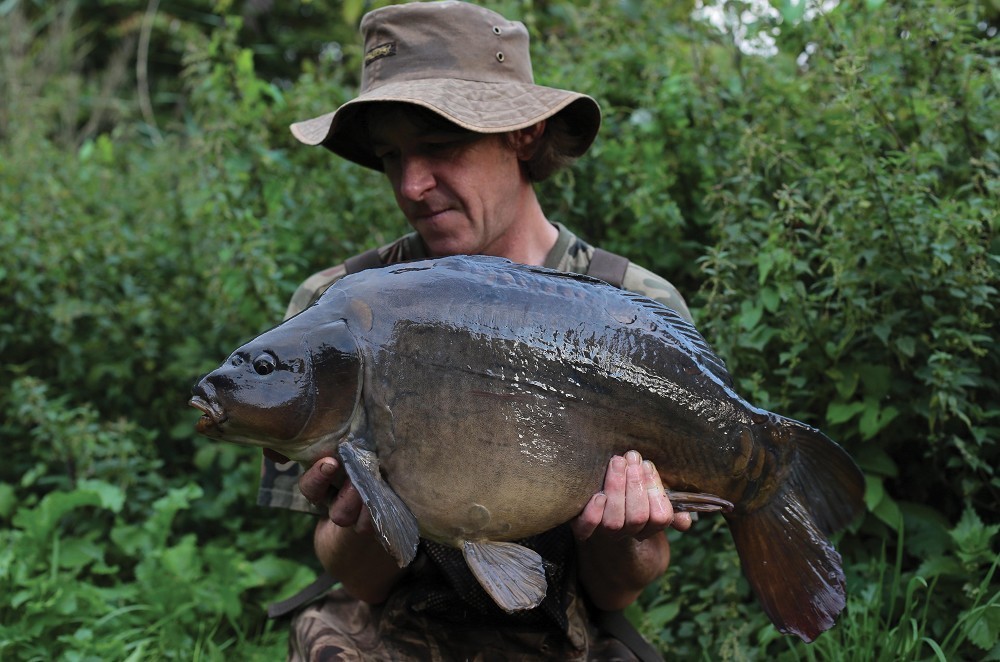 One out the edge from a clear water I dabbled on in the summer. Pretty sure my hook was sharp enough for this one
One out the edge from a clear water I dabbled on in the summer. Pretty sure my hook was sharp enough for this oneOther times there might be other things letting a hook down, maybe they’re the sharpest of the bunch but their strength isn’t quite suited to the situation I want them for. For example, in the case of the stony bottomed tidal Thames, I went through several makes of curve shank style hooks until I found the best ones, which weren’t only super sharp, they were super hard and therefore less prone to damage. It was the difference between changing rigs virtually every chuck because the points had turned over without even catching anything, to regularly reeling in and recasting with no problems at all, and catching und unhooking up to four fish on the bounce on the very same hook. That kind of thing is going to have a huge, huge bearing on your end results.
Back to the nail test for a minute, as I quickly want to dismiss the notion that adopting it might blunt your hook in someway. I promise you, as someone who’s been using it most days of my life since I was a teenager, that it will not. You aren’t trying to put it through your nail, you’re just using a slight amount of pressure to see how easily it sticks. Whenever someone comes out with the ‘nail test must blunt hooks’ thing, it’s straight away clear to me that they haven’t used it for any length of time, otherwise they wouldn’t be saying it. In the same vein, whenever someone says or writes something like, “Sharpening my hooks has made a profound difference to my fishing”, I can’t help but feel a little sorry for them, as I can only assume that prior to getting out the file they were using blunt ones. Sorry if that sounds a bit brutal, but jeez man, that’s a lot of wasted time.
Continuing on, whenever someone gives the advice of changing your hook after each fish, I can’t help but see it as an admission that they can’t tell whether it’s been dulled or not. I’m intrigued, if you change your hook after each fish then how did you know whether it was sharp in the first place? And if you did know that it was sharp in the first place then how come you’re not testing it again to see if it’s been dulled before unnecessarily changing it?
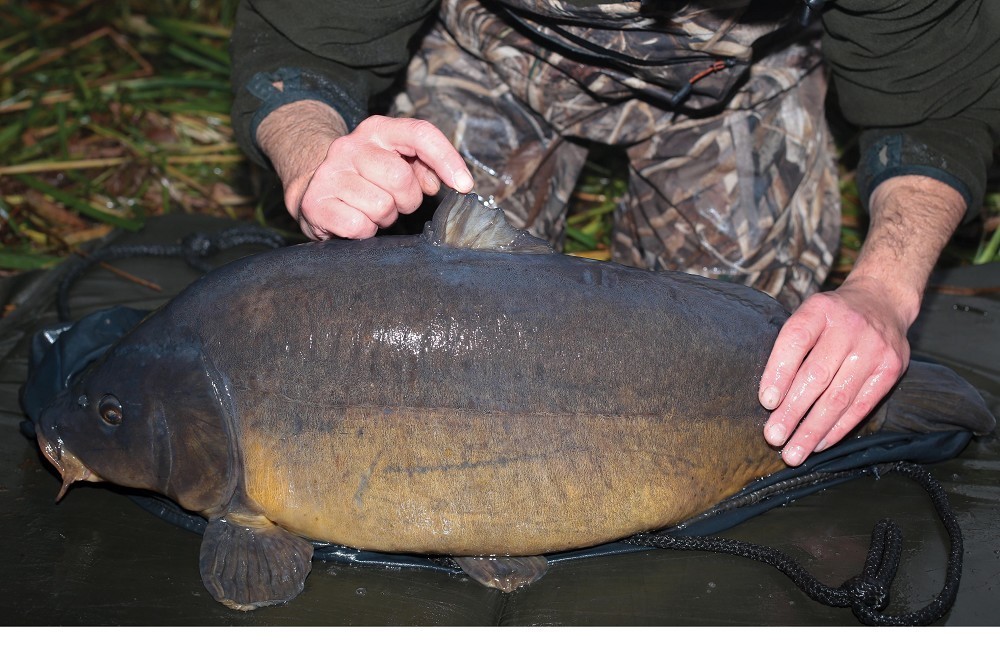 ‘Beauty through the eyes of the beholder’. ‘Almost’ a nude leather from the Estate Lake, one of eighteen carp over two nights with no losses at all. Pretty sure my hooks were sharp enough then too
‘Beauty through the eyes of the beholder’. ‘Almost’ a nude leather from the Estate Lake, one of eighteen carp over two nights with no losses at all. Pretty sure my hooks were sharp enough then tooYou know what, I’ve got to be honest and say that I’ve never met anyone who’s genuinely good with the nail test that finds the need to get out a file, strange that isn’t it. It begs the question: how many hook sharpeners out there use the nail test after sharpening their hooks, and before, for that matter? If they did then maybe they wouldn’t need to sharpen their hooks, not unless they were set on using a certain make and pattern which isn’t quite ‘there’, which is perfectly understandable. And while I’m at it, saying “It’s better to sharpen your hooks” is a pretty broad statement too, considering there’s a combination of hundreds upon hundreds of different patterns and sizes out there. Which one do you mean?
Anyway, none of that nonsense matters, what matters is we all agree that, for carp fishing purposes at least, the sharper and finer the point the better, yeah? (Anyone saying “no” right now needs to go stand in the corner with their finger on their nose). How you go about achieving that, either through learning to tell the difference between a sharp hook and a sharper hook and going through many different patterns and sizes, as I have over the years, and still happily do, or alternatively by sharpening with a file like many other successful anglers do, is entirely up to you. Do whichever you feel most comfortable with, the end result is the same, a super sharp hook on the end of your line.
Nick wrote a couple of things with mention of Jason Hayward, who’s undoubtedly played a big part in making carp anglers realise how important hook sharpness is. Jason realised the massive importance a super sharp hook has twenty plus years ago, and so he started sharpening his own, namely the Continental Boilie Hooks, as I can remember Micky getting them from him way back in the mid-nineties. Would Jason have caught as many carp if he hadn’t sharpened those hooks? No, he wouldn’t, something I’m 100% positive Jason already knows very well, otherwise he wouldn’t still be making the effort to sharpen them. He knows an edge when he’s onto one, and for an angler with limited time, anyone that knows him will tell you that he catches way above his fair share. Of course being an old hand means a lot, his knowledge of bait, watercraft etc. have been honed over many, many years, and yes, of course he still would have caught untold carp… just not as many that’s all!
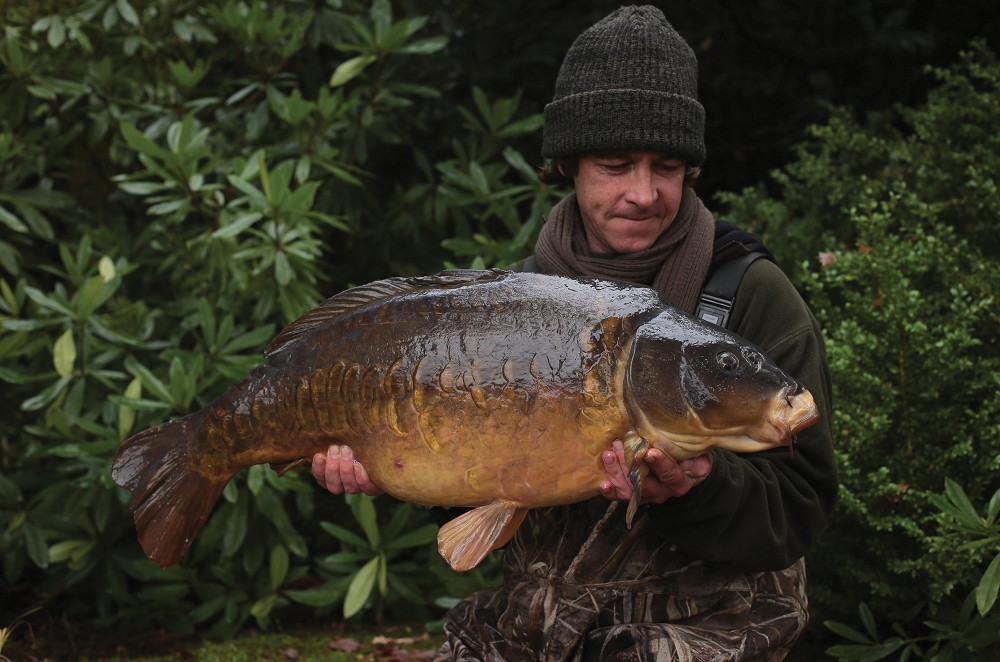 Another lovely old mirror from the same trip, a fish I’ve met once before back in ‘97. I was already paranoid about hook sharpness then, and today I’m even worse
Another lovely old mirror from the same trip, a fish I’ve met once before back in ‘97. I was already paranoid about hook sharpness then, and today I’m even worseAll of us need to be overly fussy with our hooks. If you’ve yet to get yourself into a slightly paranoid pickle about hook sharpness whilst tying up your rigs… you know what I mean, testing them over and over and over again, with half-a-dozen patterns on your lap yet you still aren’t really 100% happy with any of them… then maybe it’s time to up your game a bit.
I’ve already written more on this subject than I wanted to, but it was needed. Let’s not turn it into some kind of hook sharpening against straight out the packet war, let’s just accept that our hooks need to be as sharp as possible, and it’s up to the individual to choose how they go about it. Personally, with certain patterns I’ll quite happily file some of the arched metal off the back of a beaked point to make it more slender, therefore allowing easier penetration, but I won’t touch the very tip of the point. I like the actual point of my hooks to come in the same as they went out, which might have been up to 24hrs earlier, and on a lot of the waters I’ve fished that wouldn’t be happening if I’d taken a file to them, certainly not with bottom baits rigs anyway. Also, if I tie up half-a-dozen rigs for a session I like to know that the point on each is identical, and through careful choice of patterns and by being super, super fussy, that’s something I quite easily achieve.
A nice slender point is something I always look for in a hook, and obviously I like the way a file can hone a thicker point down, removing some of the metal on the back of a beaked point, but I recently read that this helps the hook to go in past the barb on the take, thus preventing them from shaking it free? I think that’s a bit of a misconception. The hook very, very rarely goes in past the barb on the take no matter how sharp it is, not unless you’re fishing locked up and the rod’s bucking in the rest. With the sizes that most of us use they only slide in past the barb once you’ve picked up the rod, and if truth be known, quite often during the early stages of the fight whilst you’re actually playing the fish. The theory behind it is still bang-on though, as the more of the point that goes in on the take, the less chance they have of shaking it free.
Joe Morgan wrote a good bit on sharpening hooks in one of the last Rotary Letters, and funnily enough he commented on how he’d never hooked himself before sharpening his hooks, but since doing so he’s had an accident or two. Complete coincidence but I also wrote about my most recent ‘hook up’ in the very same issue. We must both be using super sharp hooks to be hooking ourselves then mate, except mine was straight from the packet. I’ve got to admit though, that hook in your piece was super, super honed to perfection, very impressive. I’ll try some if you want to knock me up a dozen of your finest!
Blimey, I’ve just done a word count and it looks like I might just as well stick with the hook subject for this issue. To clarify, the difference a good, sharp, well chosen hook makes I’ll finish with an example from my own fishing.
Last November I had a bit of a red letter session on an Oxford Estate Lake, during which I was lucky enough to receive eighteen takes over two nights, all whilst using size 5 Drennan Barbel Hooks. They had a little tweak with the pliers, but in terms of sharpness they were straight from the packet. Obviously there’s more to the story than that, like worrying that the otters had eaten them all, and the three-hour-plus round trip for a dawn recce and to bait up the week before, but that’s a story for another time.
From the Oxford Estate Lake I then drove straight to Wasing in Reading, where again everything fell perfectly into place and I was fortunate enough to manage a further ten takes over three nights. So, two lakes, five nights, twenty-eight takes in total, a bit of a contrast when compared to my fishing on a pit with only two carp in all spring and summer long! How many would you say is a good average to land from that lot? What sort of figure would you say is a good indication that I was using hooks which were truly sharp? I’ll save you a guess and tell you: all of them.
Taking it a touch further, I’ve just checked through my notes, and after adding the fish from the trips before and after that memorable five night session, with no losses in-between, I can see that I was fortunate enough to land forty-six consecutive carp on the bounce before dropping one, and when one did drop off it was because the hook point had somehow pierced through the Hair (which kind of says something about hook sharpness in itself…). After going so long without a loss I was proper gutted as I skipped the lead back towards me, but you know what, when I swung the rig to hand and saw that the hook had pierced through the Hair I actually smiled. The way my hooking arrangement is set up, it’s impossible for that to happen after the take, not whilst a fish is on the end: it could have only happened before the take. In other words, there was a reason for the loss and that made me happy! I don’t know, with crappy averages like that, I really must stop using hooks straight from the packet… You can tell me you’re using super sharp hooks and I’ll agree, but you can’t tell me you’re using better!



